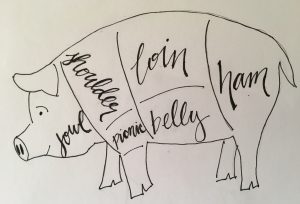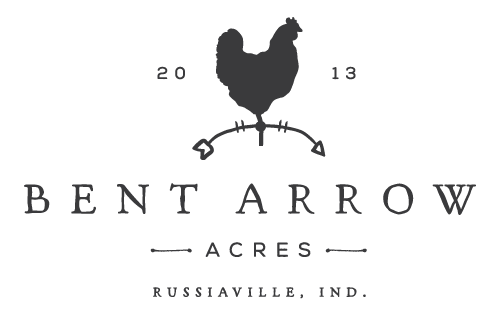25 Jul Pork Week Day 1: Cuts of Pork
Welcome to Pork Week 2017!
This week, Adam and I have a series of posts prepared all about pastured pork: how to shop for it, what to expect when you purchase a whole or half hog and more.
We are doing this because we have found that, generally speaking, there are two groups of people shopping who freezer pork:
- The first, are families that have purchased whole or half hogs their whole life. It’s what their parents did and it’s what they do too.
- And, the second, are people who have never invested in a whole animal; but, want to for a handful of different reasons from the cost savings, supporting their local farmers to knowing the animal and how it was raised.
Follow along all week to learn more to help make the entire process of shopping for, receiving and eating freezer pork easier. And, because there just might be a cool giveaway…!
A good place to start is by understanding a little more about the anatomy and butcher cuts of a pig. This will help show you what you will receive when you purchase a whole or half pig. It put things into the retail cuts, like those found at a grocery store, that you are familiar with. It will also can help you think of all the meals you can create.
Our processor, This Old Farm, has cut sheets created that focus on the following six areas of the pig. Things like lard, offal’s like the heart and liver, and trimmings to make ground pork for burgers, brats and sausage are also available.

Jowl: These are the cheeks of the pig and often called “jowl bacon” as they are cured or smoked like bacon found in the belly. They are great for pan frying or used to add flavor to beans, collards and more.
Shoulder:
Pork Steak- Great for grilling.
Boston Butt- This cut is from the top of the shoulder. This is best for pulled pork, but can be cut into steaks, roasts and stew meat. If using for pulled pork, roast it low and slow.
Picnic:
Roast- This is part of the front leg that runs from the shoulder socket to the elbow. It is good for braising, pulled pork or stew meat.
Loin:
Pork Chops- This is a rich and meaty cut from the center loin. It’s important to not overcook pork chops because they dry out quickly. They can easily be grilled, broiled or cooked in a pan.
Loin Roast- Lean, tender and touted as being the best piece of pork to roast. Also called “rack of pork” because it can include the backbone.
Baby Back Ribs- Baby Back Ribs are taken from the pig’s rib cage, near the backbone. They are small, meaty and juicy. Baby Back Ribs tend to cook quickly and the smaller they are, the more tender. They are perfect for grilling and roasting.
Tenderloin- This is a very lean and very tender cut of the pig. It cooks quickly making it nice for weeknights and entertaining. A tenderloin is great grilled, pan fried or roasted in the oven.
Sirloin Roast- The sirloin roast is typically lean and is found near the hip and backbone. Makes really great braised meat.
Rib End Roast- On a slab of spareribs, there is a long end and short end. The short end tends to be meatier and more tender.
Belly:
Bacon- A clear favorite of the pig. Adam jokes that he needs to find a way to raise pigs that are 100% bacon. Bacon is made from fatty slabs in the pigs underbelly, then smoked and cured with salt. Pan frying is how we cook bacon; but, we know plenty of people who love to cook it in the oven too.
Spare Ribs- Compared to Baby Back ribs, they are not as meaty. But, they are very tasty thanks to more fat on the cut. Spare ribs come from the underside of the rib cage. They are great for grilling, roasting and braising.
Ham:
Roast- Ham roasts come from the pigs leg. They can be plain, but most are either cured with a brine of salt and spices or smoked so they are juicy and fully cooked. They can be sold bone-in or boneless. Ham roasts are great for a crowd and at the holidays when baked.
Ham Steaks- These are ham roasts sliced into about 1/2 inch thick slabs. They are smoked and cured and make for a great breakfast after a quick pan fry.
Hock- This is the bones from the joint that attached the pigs legs to the feet. Because of all the ligaments and bones it requires long, slow cooking like braising or stewing. It is often in soups.
Do you have a favorite cut? Pork chops, bacon and brats have been some of our customer’s favorites!



Sorry, the comment form is closed at this time.